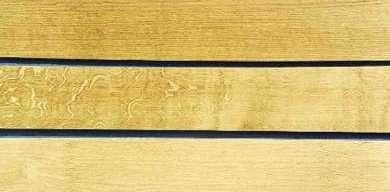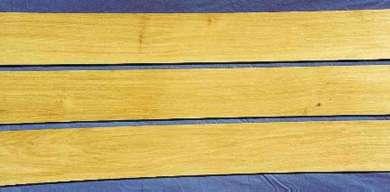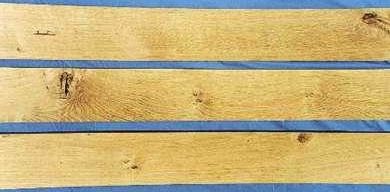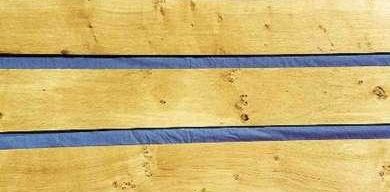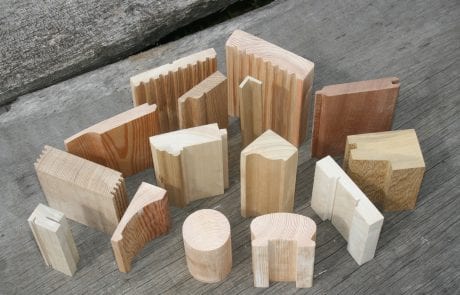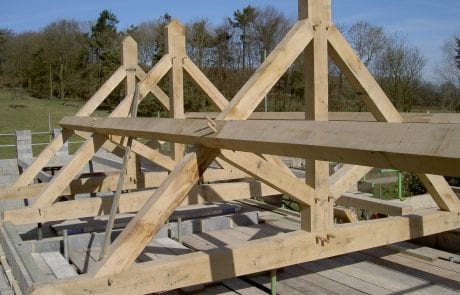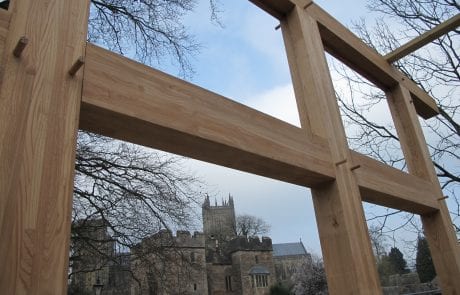Timber Species and Grading
We have listed the majority of the timber species we currently trade in. NOTE: We do not necessarily stock all species in all sizes but may be able to source the timber required. If the species you require is not listed, please contact our Sales Team.
Ash, European
Fraxinus excelsior
- Originates from Europe and Western Asia
- Light in colour – creamy to light tan. Heartwood and sapwood are not clearly distinguishable. Some specimens have streaking which is sold as Olive Ash.
- Non-durable, tough, heavy and dense timber, dries fairly rapidly and needs care to avoid degradation of the timber. Straight grain and coarse texture. Excellent for steam bending.
- Wide range of uses including: sports equipment, boat building and cabinet making. Internal use, polishes well.
Beech
Fagus sylvatica
- Grows widely across Europe
- Variety of colour shades from a pale whitish colour to pinkish brown. Steaming beech changes the colour to a darker reddish brown.
- Non-durable
- Wide range of uses: quality joinery, furniture manufacture, tool handles, flooring, plywood. Internal use.
Cedar of Lebanon
Cedrus libani
- Found in the UK and Middle East
- Brown in colour, the sapwood contrasts distinctly with the heartwood. Strongly scented and resinous. Usually straight grained with fine to medium texture. Durable.
- Dries easily, only a slight tendency to move. Easy to work. Soft and brittle with low strength ability. Used for joinery, doors, gates, fences and outdoor furniture. Internal & external use.
Cedar, Western Red
Thuja plicata
- Originates from the USA and Canada. Introduced into UK and New Zealand
- Colour varies when fresh sawn from salmon pink to dark brown. Matures to a reddish brown and in time changes to silver grey if untreated.
- Durable, but can be attacked by the common furniture beetle. Uses include shed and green house construction, shingles, cladding, exterior boarding, fences. Straight grained and coarsely textured with prominent growth rings. Works easily with hand and machine tools. Low crushing and bending strength.
Cherry
Prunus Avium
- Originates from Europe, Western Asia
- Reddish/pinkish brown darkening with age
- Straight grained with a fairly fine and even texture. Sapwood is non-durable and can be attacked by powder post beetle, heartwood is moderately durable. Similar to oak in its strength properties.
- Dries fairly quickly and can be vulnerable to warping and end-splitting if not treated with care, and therefore is used in smaller amounts for furniture manufacture, turnery, panel work and decorative joinery. Internal use.
Chestnut
Castanea sativa
- Widely found in Europe
- Colour pale to mid brown, similar to oak without the silver rays, this is due to finer rays.
- Similar to oak, the sapwood is non-durable, but the heartwood is very durable. It is difficult to dry and generally has a straight grain, with a coarse texture. Like oak, it has an acidic character which tends to corrode metal when in damp conditions. Can have blue/black marking after contact with iron/steel.
- Used for furniture, kitchen utensils, cleft fencing, stakes. Internal & external use.
Douglas Fir
Pseudotsuga menziesii
- Canada, USA, UK
- Heartwood light reddish-brown with sap being pale yellow. Straight grained but sometimes curly or wavy. The contrast between early and late wood provides prominent growth ring figure, which shows an abrupt colour contrast on plain sawn timber.
- Typically used for joinery work, roof trusses, laminated arches and beam. Moderately durable, but subject to beetle attack. Internal & external use.
Elm
Ulmus procera
- In the UK, it is only found in commercial quantities in Northern England and Scotland. This follows the decimation of elm in the South of England in the 1970’s.
- Elm has a cross grain and a dull darkish brown appearance. This results in a very attractive figuring in the timber. Non-durable and subject to insect attack.
- Used extensively in the furniture trade, although availability due to Dutch Elm disease is limited. Also used for flooring and weatherboarding. Internal & external use.
Idigbo
Terminalia Ivorensis
- From West Africa
- Heartwood is very pale yellow-brown. Grain is straight to slightly interlocked. Texture medium to fairly coarse. Generally works well, grain picks up when planed. Heartwood is durable, but sapwood is vulnerable to insect attack.
- Used for furniture and joinery. Internal & external use.
Iroko
Chlorophora excelsa
- West & East Africa
- The colour of this timber can range from golden orange through to mid to dark brown. Fairly coarse, moderately interlocked. Works satisfactorily with hand and power tools, but has abrasive properties that blunt tools quite quickly. Heartwood is durable, but sapwood is vulnerable to insect attack.
- Used in the marine industry, interior and exterior joinery. Internal & external use.
Note: The colour of Iroko can be very deceptive, it does change from yellow to chocolate brown very quickly. The yellow is not a defect.
Lime
Tilia vulgaris
- Found throughout Europe
- Colour ranges from creamy white to a yellow colour, straight grained and fine texture
- Lime is quite a soft hardwood and works easily with hand tools. Non-durable but permeable to preservable treatment.
- Used for carving due to its soft properties, and also in the musical instrument industry. Sometimes used for turning. Internal use.
London Plane (Lacewood)
Platanus hybrida
- Throughout Europe
- Heartwood is reddish brown, with very conspicuous and numerous broad rays present on quartered face. This shows on the lighter background as a decorative fleck.
- Works well with hand and machine tools. Perishable, but is permeable to preservation treatment.
- Used for cabinetmaking, furniture, panelling and ornamental work. Good for woodturning.
Maple
Acer saccharum
- Also known as Rock Maple
- Grows in Canada and USA
- Colour varies from pale cream to light tan. Straight grained, can sometimes be wavy or curly. Non-durable. Fine texture. Large trees sometimes have dark brown hearts.
- Has high resistance to abrasion and wear, suitable for flooring, joinery and sports goods. Internal use.
Oak, European
Quercus Robur
- Europe, Turkey, North Africa
- Light tan to biscuit in colour.
- Usually straight grained, but irregular or cross grained material can occur depending on growth conditions. Characteristic silver grain figure on quartered surfaces. Dries very slowly, with a tendency to split and check. Heartwood very durable. The acidic nature of oak can cause corrosion when in contact with metals, blue-black staining can occur in damp conditions when in contact with iron/steel, or when fresh sawn due to the chemical reaction with steel saws.
- Used for beams and structures, furniture, flooring, joinery. Internal and external use.
European Oak Grading Rules
To assist customers in making the correct selection of graded oak, we have put together a guide to the grades of European Oak available (subject to availability). We created this guide prior to there being any formal guidance in the UK.
Veneer Grade
- Clear of all knots on all four faces
- Generally quartered/billet sawn
- Not necessarily colour matched
- Straight grained
- No sapwood
- No brown stain
First Quality
- Graded on 1 edge and 1 face with 2m x 150mm being the benchmark size
- Sap – no more than 10% of reverse face
- Knots of up to 25mm in diameter but no more than one per 2 metres
- Frequency of knots may be greater for thicknesses of 65mm & up
- Pin knots of up to 4mm, with an accumulative area not more than 50mm in 2 metres
- Some colouration
- No brown stain
- Excludes – shake and dead knots (and heart centre in square edge)
1 – 2 Grade
Some 1st quality, some 2nd quality will include:
- Sapwood one face, no more than 25% of surface
- Sound knots on no more than 25% of the width of the board
- Cross grain included, also ‘Cats Paw’ small growths/pin knots
- Can include some discolouration – brown streaking/colour allowed
- Excludes – shake, dead knots and dead sap
Pippy grade (very limited supply)
- Will have clusters of pin knots (Cats Paw) repeated throughout
- Sound knots of up to 50mm but no more than one per 2 metres in its length
- Possibility of colour variation
- Excludes – shake, dead knots
More Species Descriptions
Olive Wood
Olea europaea
- Originally found on the Mediterranean east coast, however it is now available beyond Europe.
- Rich in colour and colours deepen with age. It tends to have very contrasting colours of yellow and brown, making it very striking. Heartwood tends to be cream/yellowish brown with black and brown contrasting streaks.
- Often displays a curly or wavy grain, although sometimes displays a straight grain. Fine textured and very durable, although it has a lack of natural oils to make it insect and rot repellent.
- Ideal for small indoor projects.
Poplar, American
Liriodendron tuplipifera
- Other Names: American Tulipwood, Tulipwood
- Eastern Canada & USA
- Pale olive-green to brown, can be light yellow to tan.
- Usually straight grained. Low resistance to shock loads, low bending strength. easy to work with hand and machine tools. It does not mould well, but is good for turnery and carving. Non-durable.
- Used for furniture, interior joinery.
Health Risk – dermatitis
Sapele
Entandrophragma cylindricum
- East, West and Central Africa
- Newly cut Sapele is often a pinkish colour, this darkens to a reddish-brown or purple-brown colour. Characterised by a well defined stripe on quartered surfaces. Grain is moderately interlocked. Moderately durable. Sapwood liable to insect attack. Works well with hand and power tools.
- Typically used for furniture, joinery, doors and worktops. Internal & external use.
Scots Pine
Pinus sylvestris
- This species come from a wide geographical area.
- When dry the heartwood is pale reddish-brown and resinous.
- It varies in strength, texture, density and number and size of knots. The annual rings are clearly marked by contrasted light early wood and dark late wood growths.
- Non-durable. Used for furniture, joinery and building construction.
Southern Yellow Pine
Pinus palustris
- Eastern Canada & USA
- Pale yellow to a light reddish brown in colour.
- Soft and very stable. Non-durable. Classified as weak in all strength categories.
- Has a variety of uses including: joinery and carpentry, furniture making and boat building.
Sycamore
Acer pseudoplatanus
- Found throughout Europe
- Colour ranges from white to creamy yellow. If not dried quickly enough after felling, a silver grey effect takes place as a chemical change occurs with the sugars in the timber.
- Generally straight grained with a fine texture. Can be found with a wavy or rippled effect, which gives an attractive figure.
- Used for its white colour in flooring, furniture, turnery and musical instruments. Internal use.
Teak (plantation grown in South America or Africa)
Tectona grandis
- Plantation grown Teak comes from South America and Africa.
- Rich brown with chocolate-brown markings. It is generally straight to wavy grained and coarse textured, oily to the touch.
- Very durable. Used extensively in the marine industry, interior and exterior joinery, flooring and garden furniture.
Note: We only supply plantation grown Teak from South America or Africa. Contact us to see whether there is supply availability and for advice on alternative timber species.
Utile
Entandrophragma utile
- Grows in West, East and Central Africa
- Pink-brown when first cut, it changes to a deep red-brown. Grain is interlocked to irregular with a wide striped figure on quartered surfaces. Moderate texture. Heavy density. Durable.
- Used for furniture and cabinet making, high quality joinery, work/counter tops. Internal & external use.
Walnut, European
Juglans regia
- Europe, Turkey and South West Asia
- European Walnut is very scarce in supply. Usually a grey brown with stripes of darker colouring irregularly distributed as streaks of darker brown.
- Moderately durable. This is a very attractive timber, used in veneer and furniture making, cabinetmaking and carving.
Walnut, American Black
Juglans nigra
- Grows in Canada and USA
- Rich, dark brown to purplish black. Tough hard timber, medium density, coarse texture, straight grain. Heartwood is durable.
- Used for high quality joinery, furniture and cabinet making, boat building and for decorative veneers and inlays. Internal or external use. Note: sapwood not durable.
- Note: Walnut trees are small in diameter which means that joinery sizes are difficult to obtain. The wood is variable and includes sapwood which is lighter in colour than the heartwood. The presence of sapwood and knots are not considered defects under the American Lumber Grading Rules.
Yew
Taxus Baccata
- Found throughout Europe and North Africa
- The sapwood and heartwood are strikingly different, with the sapwood being white and the heartwood dark golden orange brown, sometimes streaked with a purple. The grain is straight, but normally has clusters of knots and is wavy. Durable.
- Used traditionally for bow staves by English Bowmen, it is used for turnery, joinery and furniture making. Internal & external use.
Health Risk – Toxic to humans – always use a good dust mask.
NHLA Grading Rules
The National Hardwood Lumber Association of America publish clear rules on the grading of timber. Press the ‘download button’ to obtain a copy.
Making the Grade
A guide to UK hardwood timber, compiled by a variety of contributors from the UK timber industry including W L West & Sons Ltd. It was sponsored by: The Forestry Commission, Scottish Enterprise, WDA, Welsh Assembly Government, The Scottish Forestry Trust, Forest Service, European Commission & England Forest Industries Partnership. Press the download button for a copy, the file is quite large, so please be patient.
